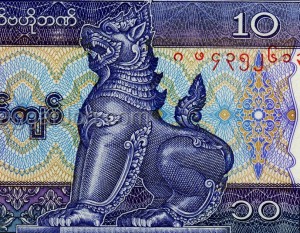Lost in transaction
 One of the most startling travel epiphanies I’ve had in recent years came on a trip to Burma, when I was counting out small change so I could buy a packet of toilet tissues. The Burmese kyat had recently suffered a jag of devaluation, and when I’d tallied up my toilet-tissue money, I noticed that it consisted of twelve small denomination bills.
One of the most startling travel epiphanies I’ve had in recent years came on a trip to Burma, when I was counting out small change so I could buy a packet of toilet tissues. The Burmese kyat had recently suffered a jag of devaluation, and when I’d tallied up my toilet-tissue money, I noticed that it consisted of twelve small denomination bills.
Given that Burmese tissues came in packets of ten, it occurred to me that it would be more economical to just wipe my ass in kyat and pocket the difference.
Though this Burma experience was an unusually vivid example, travel always has a way of testing one’s faith when it comes to the workings of money. At home, one can pass bills without thinking too much about it, but the arbitrariness of modern currency can be alarmingly apparent when one is abroad.
As a veteran Asia traveler, my bewilderment with legal tender goes back to a day seven years ago, when an elderly vendor in Phnom Penh’s Russian Market refused to accept a worn $10 bill I’d brought directly from the United States. “Too old,” she’d told me. When I asked the woman to show me an example of acceptable currency, she held up a discolored (yet crisp) $20 bill that had obviously been counterfeited locally. In Cambodia, it seemed, the true value of American money was not pegged to its authenticity, but to whether or not it was wrinkled.
Such an idiosyncrasy may well derive from fact that portable currency (a system created in part by the demands of travel itself) has never been foolproof. In areas where a standardized money system has yet to catch on, for example, the act of shopping can prove ambiguous. In the 19th century guidebook The Art of Travel, Francis Galton suggested bringing beads and shells to use as “small change” when traveling in remote regions. Galton warned against knickknack-inflation, however — noting that one African chief had complained that his women were already “grunting like pigs” under the burden of beads given to them by previous travelers.
Other times, the absence of standardized currency has worked in travelers’ favor. Pioneering voyages to the South Pacific abound with tales of an improvised iron-based economy, wherein a sailor could acquire a short-term Tahitian wife through the gift of “an old razor, a pair of scissors, or a very large nail.” In 1767, Captain Samuel Wallis of the Dolphis had to forbid his men from trading nails for anything save wood or water, “to preserve the ship from being pulled to pieces” by horny sailors. Of course, iron isn’t the only item that has served as de facto travel currency. Wandering Norsemen once brokered deals in butter, the nomads of the Sahara traded in salt, and (in a scenario that’s fun to imagine) ancient Aztecs paid off their debts in chocolate. Tobacco was legal tender along the roads of colonial Virginia — a fact that sounds strange only until you consider that cigarettes were used as money in many parts of Europe after World War II.
In fact, paper money — which carries a purely hypothetical value — has only recently caught on as a world currency. The Chinese may have valued paper notes against silk to mixed success 1000 years ago, but a similar effort in 13th century Persia was ruined by counterfeiters. William the Bad tried to introduce leather money in 14th century Sicily — though (given the king’s unfortunate name) it’s easy to conclude that this royal experiment didn’t go over so well. To this day, the uncertainty of paper money has been known to break a regime: In late 2001, forged paper notes reportedly helped destabilize the Taliban government (one naturally wonders what graven image the Afghan Islamists had printed on their money — a grenade? an unplugged TV set? a smashed chunk of Buddha statue?).
Even in the United States, a paper dollar has little inherent value beyond the fact that it’s a part of the largest system of common faith in the world. Indeed, despite doctrinal differences, Buddhists, Christians, Muslims, Jews, Hindus and animists readily accept paper dollars — and even the metaphysical workings of the dollar’s “managed system” of value (wherein American banks and the Federal Reserve determine, Old Testament-style, that a dollar Is What It Is) seems firmly rooted in the ways of shared belief.
When such faith begins to crumble, of course — like it did for me in Burma — it’s easy to conclude that, for all its usefulness, paper money is still just paper.
For the record, I went ahead and swapped those twelve banknotes for ten tissues. But only because the latter were more absorbent.

Category: Asia, Money Management